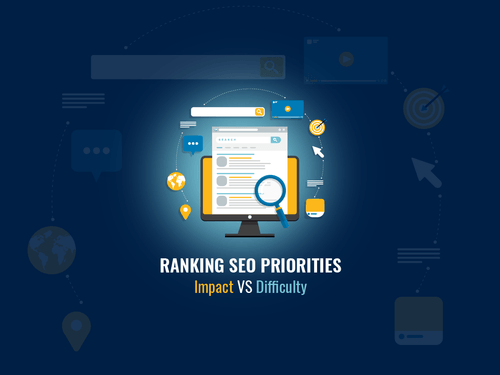Let’s say you’re starting a business. Where do you begin? Do you come up with a product or service and find customers for it? Or, do you identify a group of people with a need and create something that solves their problems?
Put that way, it seems obvious. Of course, you should make sure there’s demand for what your organization offers. Yet all too often, companies try to reverse engineer their marketing efforts.
This is what we do, and we do it well. This is what we produce, and we make it efficiently. So, who can we sell it to? The marketing department should be able to figure it out, right?
It certainly is a marketer’s job to know the ins and outs of the target market. But, let’s be clear. This should be a two-way street. Marketing insights fuel business decisions and business goals prompt marketing strategy.
Whatever direction you’re heading on that two-way street, you need an understanding of the customer mindset.
One of the biggest mistakes in marketing is focusing too much on your company instead of your customers. Visit some websites, and you’ll see plenty of copy on the Home page gloating about how amazing the company is. About pages celebrate the history of a company founded in 19-whatever, lauding accomplishments and meaningless milestones. Company blogs brag about the newest technology and latest industry awards.
There’s nothing wrong with that stuff in moderation. But, it’s unlikely to play a significant role in persuading your prospects to make a purchasing decision. Most people will simply say, “Who cares?” They need straightforward answers on how you can help them now.
Think about a first date with someone who constantly boasts and talks about themselves the entire time. Do you like and trust them? Are they easy to relate to? Can you stand being around them? Probably not.
Now, think about a first date with someone who is genuinely interested in you. They ask questions about your life, your goals, and your interests while listening to your complaints and difficulties. Then, they might share a relatable story with you. Or, maybe they’ll offer you some sage advice based on your conversation.
I’m betting you’d be much more willing to trust the second person, and you no doubt found them much more likeable than Mr. Big Shot. So, is it any surprise that people hit the back button after five seconds on a website full of egotistic content?
Why do so many businesses miss the opportunity to make the customer the hero in marketing campaigns and digital content?
No matter how many times you hear how important it is to put the customer first, it’s easy to fall back into the trap of swaggering self-admiration. Even the best marketers do it now and then. That’s because there’s a lack of insight into the worldviews, lifestyles, and overall mentality of prospective buyers.
If you want to create content and launch marketing campaigns that resonate with the people you’re trying to reach, you need to get inside their heads. You need to find out what makes them tick. What they love and hate. What they aspire to achieve and fear becoming. What they believe and what they think is bull crap.
It sounds a little dramatic. But the more you know about your prospects, the easier it is to attract them, engage them, and turn them into loyal customers.
Here are five tools to help marketers gain a better understanding of their customers’ mindsets:
1. Buyer Personas
If you could play Dr. Frankenstein and patch together aspects of your best customers and top prospects into one person, what would that look like?
A buyer or user persona is a strategic marketing tool that creates a picture of your ideal customer, which isn’t necessarily your typical customer. However, you shouldn’t manufacture an imaginary person who fits your products and services, strengths and weaknesses, or your marketing plan. You need to do some actual research.
Persona development generally involves both primary and secondary research. You should be scouring the web for relevant existing studies and stats about the types of people you want to reach. These will often clue you into trends and big-picture preferences, which gives you a place to start strategizing.
Buyer personas often include an avatar with a unique name and backstory
Even more importantly, you should spend time picking the brains of the people who regularly work with your target market as well as actual customers and prospects. You can get some valuable help from sales and customer service reps.
In many cases, sales associates connect with prospects as they get further along a path to purchase – closer to making a sale. Potential buyers have already done research and compared their options. Customer service reps are more likely to come in contact with frustrated or dissatisfied people. But, what if there are stories about your company that your customers and prospects are keeping to themselves?
While sales and customer service will give you insights into certain things prospects and existing customers may be unwilling or unlikely to admit, don’t shy away from real customer interviews. Understanding the customer mindset requires knowing what sparked the need, how they researched and pursued a solution, and to whom they compared you before contacting sales or customer service.
An important thought on buyer personas: Focus on psychographics over demographics. Psychographics, or the attitudes, interests, beliefs, and values of your target audience tell you more about human behavior. Demographics, such as age, gender, ethnicity, income, and education don’t tell you much on their own. But, demographics can be a starting point that helps get you closer to the heart of the matter.
2. Surveys and Focus Groups
While customer interviews give you intimate insights into an individual’s decision-making process, surveys and focus groups are strategic marketing tools that give you broad yet accurate information on your target market.
Surveys and focus groups can help you develop better personas, but they’ll do even more than that. You can learn from statistics revealing how your target audience views your brand, how they compare you to the competition, how they’re influenced by others, differences among demographics, and where your company is exceeding expectations or falling short. It all depends on the questions you ask.
For example, Element used a survey for a client in the financial services industry to identify a weak spot with a key competitor that was also a major pain point for prospects. That insight helped inspire concepts for a digital ad campaign.
Original research can also inform the marketing team on the kinds of content that should be created to add value for customers. Statistics that come from surveys are hard numbers that add credibility to articles and can be repurposed as shareable social media factoids.
3. Journey Mapping
The strategic marketing practice of detailing a persona’s path to purchase or buyer’s journey is often referred to as journey mapping.
The goal is to outline the steps your ideal customers take as they move from needs awareness to research to consider and comparison, ultimately making a purchase decision and becoming a loyal customer/brand evangelist. You can use what you learned through persona development and customer surveys or focus groups to help plot out your journey maps.
These tools can consist of a few simple steps, they can be complex intertwining mazes, or you can have both. The path to purchase guided by a digital marketing strategy is nonlinear and multifaceted. But, it can also be helpful to simplify things to their lowest common denominator.
In a blog post for TopTal.com, Bree Chapin used the customer journey map for The Smithsonian below as an excellent example of how a journey map can connect online and offline activities.
4. User/Usability Testing
What if you could take a peek inside the minds of your customers as they visit and use your website? That’s the goal of user testing and usability testing.
Focus groups are a good way to get reactions and hear opinions from a small group. User testing and its cousin, usability testing, provide similar results. They’re especially useful for getting into the minds of customers when it concerns digital products such as your website experience or a mobile application.
Vipul Mishra did a nice job explaining the main difference between user testing and usability testing on Medium’s UX Blog. To paraphrase: user testing lets you know if people need it, usability testing shows you how well they’re able to use it.
User testing evaluates the validity of an idea. Usability testing looks at the effectiveness of an existing product or platform’s design, function, structure, and appropriate messaging.
There are simple ways of doing this. You can ask friends, family, co-workers, or current customers to try something out and give you feedback. There are also marketing agencies and online platforms that do this kind of customer research as a service.
It may be difficult to get users for testing purposes if your target customers are more specific B2B personas, such as the C-suite, investors, architects, engineers, or other high-profile individuals. However, this type of research can be very useful in B2C marketing, especially for e-commerce.
You can watch video and audio of people using the site as they try to accomplish the goal of locating a product, adding it to the cart, and checking out. It is eye-opening to see where people hit roadblocks as they navigate a website.
5. Analytics
Understanding customer behavior should be an ongoing process. That’s where tools such as Google Analytics, customer relationship management (CRM) solutions, and many other reporting platforms are able to deliver information that marketers can use to develop audience insights.
The tricky part is identifying the metrics that are the most important to your efforts, gaining insights from those statistics, and using those insights to make decisions about how to market to your audience and run the business.
It’s easy to get caught up in all the numbers that come out of reporting platforms. Some people get overwhelmed and others get distracted because there are so many different ways to interpret the data. Still others focus on vanity metrics, or only highlight statistics that make them look good in front of the boss. If the right person is parsing the data, however, it’s like putting on a pair of eyeglasses after walking around in a blurry haze for years.
When choosing which metrics matter to your marketing efforts, start with your business goals in mind. What do you want to achieve? Then, identify the measurable actions that indicate you’re making progress toward a specific goal.
Studying analytics allows you to see what your prospects are most interested in, where you have room for improvement, and where new opportunities lie.
The Importance of Empathy in Marketing
Remember that your marketing data tells a story. Behind all those numbers are real people.
Whether you are crunching statistics or coming up with creative campaigns, marketing is all about psychology and human behavior. It’s emotions first, and logic second. That goes for both B2C and B2B audiences.
As modern marketing expert Seth Godin points out, “Empathy is the hard part … the rest is mechanics.” Understanding the customer mindset involves putting yourself in their shoes, and all the tools and processes we’ve outlined in this post are meant to help you do that.
As Godin explains:
“People act based on the way they see the world. Every single time. Understanding someone else’s story is hard, a job that’s never complete, but it’s worth the effort.”
Need a hand becoming more empathetic to your customers and prospects? Want to explore the innerworkings of their minds? Element starts every campaign by considering the customer’s outlook and attitude. Many large projects and partnerships include in-depth audience research.
Whether it’s buyer persona development, surveys and focus groups, or marketing analysis, our team is ready to connect with yours to unravel the mysteries that lead to better business decisions. Contact us today to learn more.











